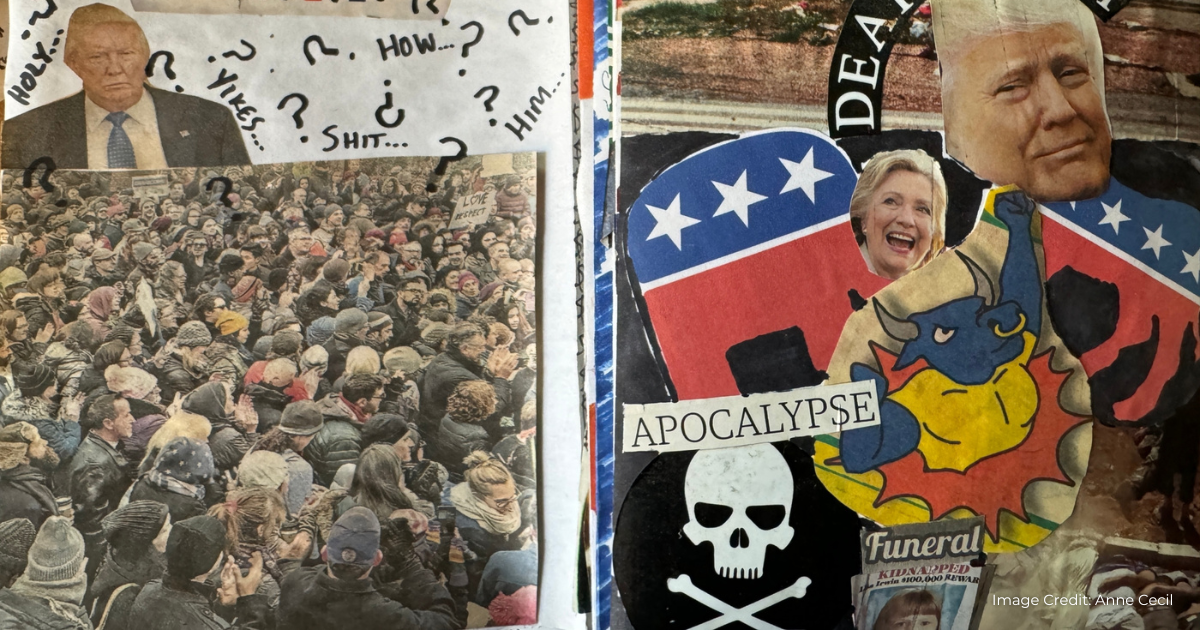How My Students’ Zine Forecasted the Future
by Anne Cecil
As I developed the chapter on “Teaching Punk Culture” in my book, Punk Rock Women Alive and Well in South Philly: Friends Are the Family You Choose, I was pleased to revisit a ‘zine that my students had created just 2 weeks after Trump won the 2016 election. They attacked ‘zine making with physical gusto, using lo-fi tools to create pages, ripped and cut imagery and text from various print materials merged with hand written commentary using sharpies, pencils and pens. It was a testament to the style of early zines from the late 70’s – the 80s before ‘zine makers began to mix technology into their tool kit. AND they had a lot to say.
I was interested to find that so many of the concerns raised were pre-cursors to the concerns that made headlines during the pandemic, affecting so many teens and young adults. These worries have been common for youth of all modern generations, but the advent of the internet and the isolation of the pandemic exacerbated worries into unease, distress, agitation and anxiety, driving too many into poor mental health, self-harm and even suicide.
I identified six themes in the ‘zine determined by number of occurrences, ranked from most to least: Anti-Establishment /Power, Mental Health/Self Care, Social Justice & Gender, Media, Technology & Censorship, Economic, and Fashion. Of these themes, Economics focused specifically on student debt and Fashion was the only category that included both criticism and commendation. The other five were presented in a negative, dark and hopeless light.
Six Zine Themes that Forecasted the Future
(1) Anti-Establishment/Power
By far the Anti-Establishment/Power theme was the strongest. The most pages were devoted to it and the imagery was angry. Much of the anger was directed at the election of Trump, but there was plenty to go around toward politicians, the wealthy and the system. The root of the anger coalesced around a feeling that there was no future for the students. Students were concerned about jobs, student debt and the environment, not so different than my college days in the early 1980s. I was reminded of the 1977 Sex Pistols song, No Future. The song’s final chorus is:
“No future for you, no future for you
No future, no future for me
No future, no future for you
No future, no future for me
No future, no future for you” (https://genius.com/Sex-pistols-no-future-lyrics retrieved 10/15/2024)
(2) Mental Health/Self Care
The next theme on the list is Mental Health/Self Care. This theme was really boiled down to pressure. Pressure to perform in school and life and to conform to a cultural context of beauty. Pressure from bullying. There is documented evidence that pressure can cause anxiety. Again, a song from my youth popped into my head, the 1981 David Bowie/Queen collaboration Under Pressure. These particular lyrics express the overall tenor of student commentary, “That’s the terror of knowing what this world is about, Watchin’ some good friends screamin’, ‘Let me out’” (google search for lyrics, retrieved October 15, 2024).
There was, however, a small glimmer of hope in this theme. One student took the stance that self-care is not self-indulgence, a harbinger of what was to come. We saw the rise of self-care during the pandemic and it continues to be a strong retail category today.
(3) Social Justice & Gender
The third theme surrounded Social Justice & Gender, mostly surrounding toxic masculinity, marginalization of women and women leaders, and erosion of women’s rights. One of the pages is strictly devoted to My Body, My Choice. The young women recognized the seeds for the 2022 overturning of Roe were being sewn. One student took a strong stance against police response to environmental protest. This too was a sign of what was to come, culminating in the George Floyd protests seen in 2020.
(4) Media, (5) Technology, and (6) Censorship
Media, Technology, and Censorship rounded out the top four categories. Concerns in this area included tech overloads, an anti-celebrity movement, censorship related to cancel culture, and a search for the truth. Research shows that constant connection with technology can lead to poor self-esteem, inadequacy, isolation, and can increase stress, anxiety, and depression. None of this has gotten any easier. As noted in the book, the average time per day spent with digital media will be about 8 hours by 2025. Students wanted to disconnect and live in the moment. It is interesting to note that zine making was allowing them to do just that.
Reflecting on the ‘zine my students created, I was struck by how relevant their concerns were, not only in the immediate aftermath of Trump’s election but also foreshadowing the struggles many faced during the pandemic. Their expressions of anger, anxiety, and frustration reflected broader societal challenges, from systemic injustice to mental health crises to gender inequality. Rooted in punk’s DIY ethos, the ‘zine provided them a non-digital, permissive space to channel their frustrations and navigate an uncertain world.
As educators, we can learn from this experience, recognizing the power of creative expression as a tool for students to process and reflect on their realities. Whether through art, writing, or music, fostering these outlets can empower young people to confront complex issues and find their voice amid the noise.
How is the Philadelphia Punk Rock scene defying gender stereotypes and empowering women to push boundaries and transform their lives?
Drawing on personal experience and interviews, this book explores the important part women play in the Philadelphia Punk Rock scene as creators, cultural producers, community and infrastructure builders, and institutional developers. Author Anne Cecil examines the rise of the Philly scene in the wider Punk context and how, based on location and community, it diverged from the aggressive, masculine stereotype.
Discussing themes of social identity, community, and empowerment, Punk Rock Women is ideal reading for students of Fashion and Style, Gender Studies, Sociology, and Cultural Anthropology.
We want our books to be available to as many people as possible. If you’d like to purchase an individual copy, please email us and we’ll give you a discount code:
HEADER IMAGE CREDIT: Anne Cecil. Used with permission.




